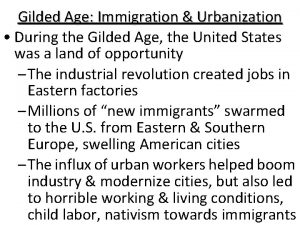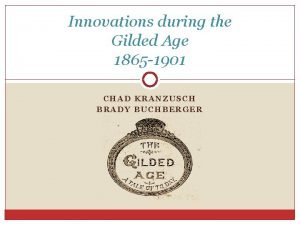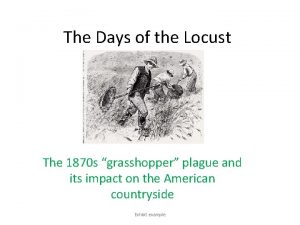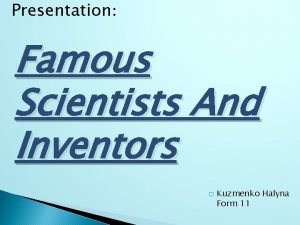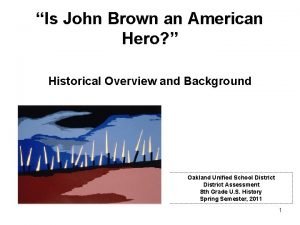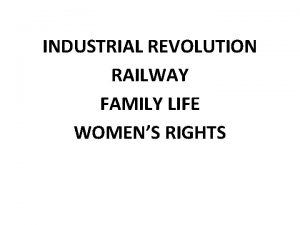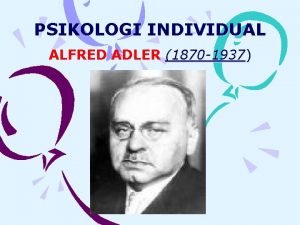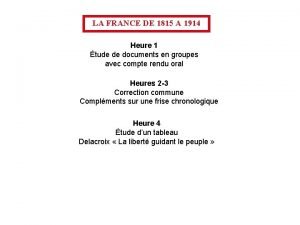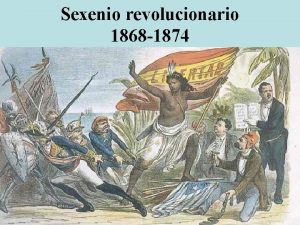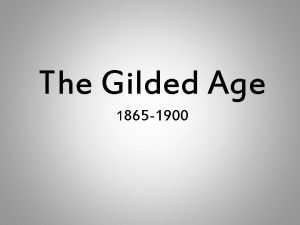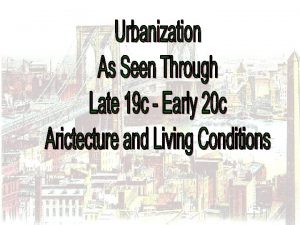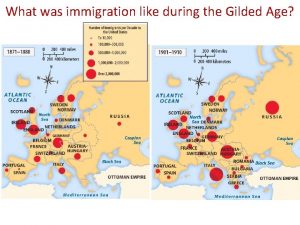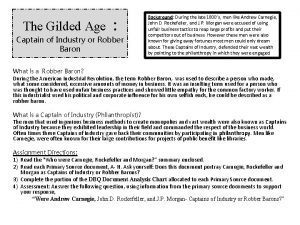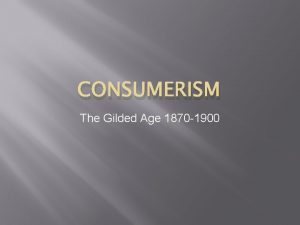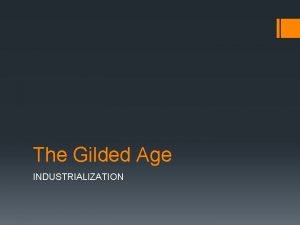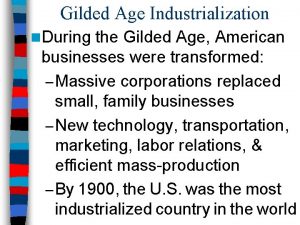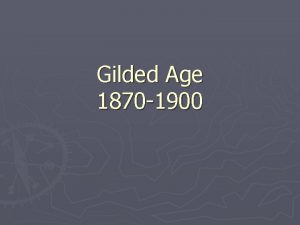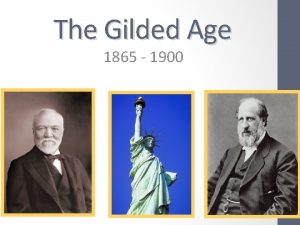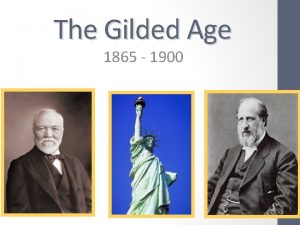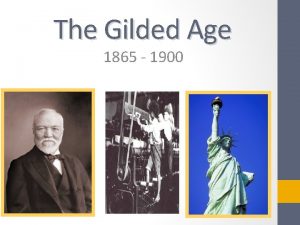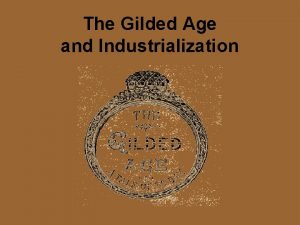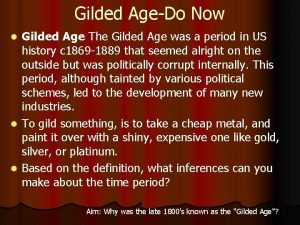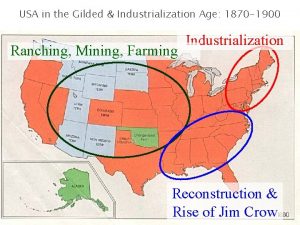Gilded Age Industrialization During the Gilded Age 1870






















- Slides: 22

Gilded Age Industrialization ■ During the Gilded Age (1870 -1900), the United States experienced an Industrial Revolution: –New technology, transportation, efficient mass-production spread ideas & industrial products –By 1900, the U. S. was the most industrialized country in the world.

An Age of Invention ■ The Gilded Age was an Age of Invention U. S. Patents Issued (1850 -1899)

An Age of Invention ■ The Gilded Age was an Age of Invention What is it? machines, registers, adding business typewriters – Cash – Alexander Graham Bell invented the first telephone – The Bessemer process transformed iron into stronger, lighter steel

An Age of Invention ■The Gilded Age was an Age of Invention –Thomas Edison (Wizard What is it? of Menlo Park) was the greatest inventor of the 1800 s –In his research lab in New York, he created the 1 st audio recorder, phonograph, batteries, –His most influential invention was the 1 st electric light bulb

The Business of Invention ■ New innovations allowed for increased industrial production –New machines were incorporated into the 1 st assembly lines allowed for faster mass production –Railroads linked all regions –America’s wealth of iron, oil, coal, immigrant labor, & investment capital (money) supplied factories

The Industrial Revolution was fueled by 4 industries (R. O. S. E. ) Railroads, Oil, Steel, Electricity

Cornelius “the Commodore” Vanderbilt was the most powerful figure in the railroad industry Jim Fisk

Oil provided kerosene lighting & lubrication for industrial machinery

Steel Production

Steel Production ■ Steel transformed world industry: –Allowed for taller buildings, longer bridges, stronger railroad lines, & heavier machinery Wadsworth Building, NYC

International Steel Production, 1880 -1914

Efficiency & Mass Production in Factories

New Forms of Business Organization ■ Corporations in the Gilded Age used mergers to increase profits –Companies used horizontal integration to buy similar companies to reduce competition –Vertical integration allowed companies to buy companies that supply raw materials or transportation for their products

Vertical & Horizontal Integration

U. S. Corporate Mergers By 1900, 1% of U. S. companies controlled 33% of all industry

The Monopolists ■ Andrew Carnegie created the Carnegie His company made more Steel Company: steel than all the factories –Heofconverted Great Britainto the Bessemer process & was able to out-produce his competition & offer better quality steel at lower prices –He mastered vertical integration to lower his production costs

Andrew Carnegie’s Carnegie did not pay his rise from a very poormuch & employees did not allow unions in Scottish his factories… immigrant to one of …but the richest he was a men in the worldwho gave philanthropist was thetogreat money New York City libraries, colleges, & example of the performing. Dream” arts institutions “American

The Monopolists ■ John Rockefeller created the Standard Oil Company –He used horizontal integration to create a petroleum company that monopolized the oil industry, lowered costs & improved quality –By 1879, Standard Oil sold 90% of all U. S. oil & sold to Asia, Africa, & South America

Rockefeller was labeled a “robber baron” who took advantage of immigrant workers, driving …but Rockefeller gave away his competition $500 million to charities, created the Rockefeller out of business, & Foundation, & founded theused his fortune to influence the University of Chicago national gov’t…


The Monopolists ■ Monopolists justified their wealth: –The “Gospel of Wealth” Wealth argued that it is God's will that some men attained great wealth –Social Darwinism taught that natural competition weeds out the weak & the strong survive –Gov’t should embrace a laissezfaire (hands off, no regulations) attitude towards “big business”

“Robber The “Robber Barons” of theof Gilded the Past Age
 Urbanization during the gilded age
Urbanization during the gilded age Meaning
Meaning Gilded age innovations
Gilded age innovations 1870 locust plague
1870 locust plague Strengths and weaknesses of the forster act 1870
Strengths and weaknesses of the forster act 1870 Halyna kuzmenko
Halyna kuzmenko 1870
1870 John brown the martyr currier and ives 1870
John brown the martyr currier and ives 1870 Frise chronologique 1815 à 1870
Frise chronologique 1815 à 1870 Over land by rail’, gustave dore, 1870
Over land by rail’, gustave dore, 1870 Adler mengemukakan bahwa tujuan akhir hidup manusia adalah
Adler mengemukakan bahwa tujuan akhir hidup manusia adalah Frise chronologique france de 1815 à 1914
Frise chronologique france de 1815 à 1914 Rey de españa entre 1870 y 1873
Rey de españa entre 1870 y 1873 Maria montessori birth and death
Maria montessori birth and death Iron age bronze age stone age timeline
Iron age bronze age stone age timeline Iron age dates
Iron age dates Wannamaker's
Wannamaker's Gilded age gallery walk
Gilded age gallery walk Gilded age time period
Gilded age time period Dumbell tenement
Dumbell tenement Gilded age
Gilded age Jp morgan robber baron or captain of industry
Jp morgan robber baron or captain of industry Gilded age consumerism
Gilded age consumerism
